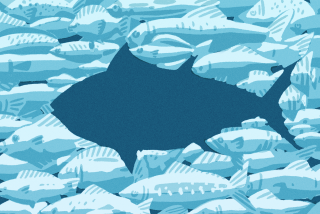What? Tuna Again?
- Share via
The results were decidedly mixed when Chicken of the Sea International recently completed a market research project. A hefty percentage of consumers still remembered the company’s “Ask Any Mermaid You Happen to See” jingle. But a surprising number didn’t know how to whip up a simple tuna salad.
So when Chicken of the Sea returns to TV screens in January after an eight-year absence, the company’s ads will highlight its familiar mermaid and song. And the San Diego-based company will fill print ads and in-store displays with recipes for everything from venerable tuna salad to quirky newcomers like tuna with granola and tuna with oranges and cashew nuts.
Chicken of the Sea, the third-largest tuna brand sold through grocery stores, isn’t the only tuna company returning to the airwaves to fish for better sales. Faced with an industrywide slump, Bumble Bee Seafoods, the No. 2 brand and also San Diego-based, is back on TV after more than a decade. And market leader H.J. Heinz Co.’s Star-Kist brand, with more than 40% of the market, has returned to the tube after a lengthy absence.
Tuna sales have declined in four of the last six years, according to Nielsen Scantrack, slumping to $1.1 billion in 1997.
Observers blame the sales slide on a failure to counter strong advertising for competing foods such as pork, beef and chicken.
The industry has also failed to ignite consumer interest with new recipes--and to introduce new cooks to old favorites like tuna salad. The result: Even though 90% of American households stock tuna, most consumers view it as a once-in-a-while meal.
But all of the major tuna producers have strong weapons in their arsenals as they rekindle advertising. Each of the three companies owns stylized mascots--a bumblebee, a mermaid and Charlie, Sun-Kist’s perpetually sorry tuna--that are likely to connect with brand-conscious shoppers.
Using those familiar logos “sounds like a good strategy,” said Terry Witkowski, a marketing professor at Cal State Long Beach. “Many consumers are price-sensitive, but they do buy things with aesthetic appeal, and you know that these familiar commercials will catch the eye of baby boomers.”
*
But observers say the industry will face an uphill fight in weaning consumers from coupons and price discounts that tuna canners have used during a lengthy price war. Although prices have begun drifting higher in recent months, cost-cutting by the industry makes it possible for retailers to sell a 6-ounce can of tuna for about 70 cents--less than shoppers paid a decade ago.
“We and the other firms all participated in the ‘commoditization’ of our industry,” said John Stiker, Bumble Bee’s marketing director. “We worked as hard as possible to squeeze every bit of cost out of our operations. And while that had benefits for consumers, there was a downside for producers.”
The price wars have inflicted casualties. Earlier in the decade, Bumble Bee and Chicken of the Sea each spent time in U.S. Bankruptcy Court. Observers tied the companies’ past woes to the price war and the relatively weak financial condition of the firms’ former owners.
Both companies were sold in recent years. Bumble Bee is part of International Home Foods, a unit of Hicks, Muse, Tate & Furst Inc., a Dallas-based investment firm. Chicken of the Sea, formerly Van Camp Seafood Co., was purchased in August 1997 by Thai Union International Inc., a leading Thai tuna processor; Tri-Marine International Inc., a tuna trading company; and Edmund Gunn, a tuna boat owner.
Producers say consumers view tuna as a healthy food that’s not as susceptible to bacterial contamination as beef or chicken. And the dolphin-kill worries of the mid-1980s have subsided.
Company executives acknowledge that their failure to advertise has slowed demand. And when shoppers do drop tuna into their grocery carts, they’re usually shopping by price, not brand.
Once a product becomes a commodity, said Kevin Lane Keller, a marketing professor at Dartmouth University, it’s hard to reverse consumer perceptions. “You can’t call time-out when you’re trying to build your brand,” Keller said, adding that tuna companies hurt themselves by not spending consistently on advertising.
Unlike other commodity-driven segments of the food industry, the big tuna companies can’t take advantage of pooled advertising that’s designed to boost overall product consumption.
“Milk is a great example where consumption was dropping for 20 years and the ‘Got Milk?’ campaign helped to turn things around,” Keller said. “But unlike milk, beef and pork producers, tuna companies will be knocking each other on the head for individual market share, rather than building the whole market.”
To breathe new life into their brands, Keller added, tuna companies must “figure out exactly what button to push to make people want to go out and buy more tuna fish,” Keller said. “That’s what the share-of-stomach battle is all about.”
The canners say their first step is simple: Give shoppers more reasons to buy tuna.
“They might think of it for Saturday lunch, but we’ve got to get them thinking about it on Wednesdays too,” said Don George, marketing executive vice president for Chicken of the Sea.
The new TV commercials are designed to appeal to kids, who eat much of the tuna sold in this country, as well as moms, who still prepare most of the meals.
Commercials will emphasize tuna’s healthy attributes and ease of preparation.
Canners are also pitching new recipes because, as George notes, “research shows that many younger women don’t know how to make tuna salad.”
Chicken of the Sea pitches its product as a tasty replacement in any recipe calling for chicken. The company’s test kitchen has also developed dishes aimed at younger palates. Recipes suggest a blend of tuna and granola, tuna with crushed pretzels and peanuts, and tuna with orange and cashew nuts.
Bumble Bee offers shoppers an in-store quarterly newsletter that’s stuffed with recipes ranging from a basic tuna salad to an oven-broiled BLT topped with tuna and melted cheese.
Companies are also offering new products designed to appeal to a wider array of customers. Star-Kist offers Charlie’s Light Lunch Kit, a ready-made tuna salad with crackers, and a line of upscale tuna products such as flaked tuna dressed in lemon juice and pepper.
Bumble Bee’s new advertisements focus on a comparative study that shows its product to be better-tasting than the competition. Bumble Bee maintains that the enhanced taste is made possible by technological advances that move fish more quickly through the processing and packing steps.
*
As tuna canners try to bolster consumption of their mainstay product, they’re also trying to branch out into related categories with fatter profit margins. Chicken of the Sea sells canned oysters, crabs and shrimp, for example, and Bumble Bee also is unveiling a higher-priced line of canned seafood.
Martyn Straw, president of Interbrand Group, a New York-based corporate identity and brand consulting firm, suspects that success will depend on the canners’ leveraging their relatively well-known brand names and logos.
Rather than focusing on market share in the tuna arena, where profit margins are slim and shoppers have been trained to shop by price, Straw suggests that owners use their recognizable brands to build market share in more profitable kinds of seafood.
Bumble Bee entered the upscale canned seafood market earlier this year after its parent company acquired Orleans Seafood, a New Orleans-based producer of canned shrimp and crab. The Orleans brand will still be sold in select markets where it has strong name recognition, but Bumble Bee is betting that its better-known name will grab sales elsewhere in the country.
“The market is now dominated by regional brands with names that don’t really jump off the shelf at consumers,” said Bumble Bee’s Stiker. “We know our revenue is going to continue to come largely from tuna, but we do want to leverage our brand with new products.”
(BEGIN TEXT OF INFOBOX / INFOGRAPHIC)
Tuna Helpers
Tuna sales have been flat for several years, prompting the big three tuna canners to return to television advertising after lengthy absences. Canned tuna is a staple in many households, but consumers aren’t buying as much as they used to.
Canned Tuna Sales
In billions of dollars, for the 52 weeks ended the first week of December each year:
Through Dec. 6, 1997: $1.097 billion
Market Share For Canned Tuna Products*
Star-kist: 41.8%
Bumble Bee: 26.1%
Chicken of the Sea: 14.5%
Private labels: 10.8%
Star-kist Charlie’s Light Lunch Kit: 1.6%
Three Diamond: 1.4%
Geisha: 1.3%
Star-Kist Select: 0.8%
Empress: 0.4%
Carnation: 0.3%
Progresso: 0.3%
*Grocery store sales for the year ended April 26; food service accounts not included.
Note: Numbers do not add up to 100% because of rounding.
Source: Nielsen Scantrack, Information Resources Inc.
More to Read
Eat your way across L.A.
Get our weekly Tasting Notes newsletter for reviews, news and more.
You may occasionally receive promotional content from the Los Angeles Times.










